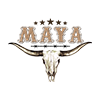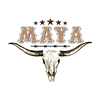Personalization at Scale: Using DTF Transfers & UV DTF for Variable‑Data Custom Apparel
Personalized apparel is one of the highest‑margin, fastest‑growing segments of e‑commerce for entrepreneurs, small brands and Etsy/Shopify sellers. DTF transfers and UV DTF technologies make it possible to add names, numbers and photos to blank t‑shirts, hoodies and hats with speed and consistent quality — ideal for print‑on‑demand (POD) and dropshipping models. This long‑form guide covers everything from basic concepts to advanced workflows, pricing examples, quality control and concrete steps to scale your personalization business with MAYA TX.
What Are DTF Transfers and UV DTF?
DTF transfers (Direct‑to‑Film) use pigment inks printed onto a PET film, then covered with a finely powdered adhesive, cured, and heat‑pressed onto garments. UV DTF applies UV‑curable inks and uses UV light to instantly cure prints — useful for specialty surfaces and fast throughput.
Both methods enable full‑color prints, photographic detail and variable data (unique names/numbers per garment) without the plate or screen setup costs of traditional screen printing.
Why Choose DTF/UV DTF for Custom Apparel?
- Low setup cost: No screens or embroidery digitizing fees make one‑off personalization affordable.
- Full‑color capability: Photographs, gradients and halftones reproduce accurately.
- Fabric flexibility: Works on cotton, blends, polyester and many hat panels.
- Fast turnaround: Print and transfer workflows suit POD and dropshipping timelines.
Key SEO Keywords to Target
Throughout this article you’ll see the main keywords optimized for search intent: DTF transfers, UV DTF, custom apparel, blank t‑shirts, hoodies, hats, embroidery, print‑on‑demand, and dropshipping. Use these terms in your product pages, meta tags and category descriptions to attract buyers searching for personalized apparel solutions.
DTF Transfers vs. UV DTF vs. Alternative Methods
Choosing between technologies depends on the job. Here's a quick comparison to guide decisions:
- DTF transfers: Best for standard garments like blank t‑shirts and hoodies. Soft hand, durable prints, excellent color vibrancy.
- UV DTF: Best for hat panels, harder substrates, and for cases where instant curing and specialty inks are required.
- Screen printing: Ideal for high‑volume, single‑design runs — low unit cost at scale, but poor for variable data.
- Embroidery: Premium, long‑lasting, and desirable for polos and caps — but not suitable for photographic personalization and higher per‑piece cost.
Combining methods is common: use embroidery for logos and DTF for photos/names to create premium, multimodal merch.
How Variable‑Data Personalization Works (Workflows)
Variable‑data personalization means every item can be unique. Here’s a robust workflow for handling orders efficiently:
- Collect personalization data: Use form fields, file upload, and preview widgets on your storefront.
- Template and automation setup: Create templates (front chest, back number block, sleeve, hat crown) with dynamic placeholders for names, numbers and images.
- Batching and gang sheets: For production efficiency, gang multiple unique transfers onto a single film sheet where possible.
- Print, powder, cure: RIP software manages white underbase and ink channels; apply adhesive powder and cure according to material specs.
- Press and finish: Heat press transfers onto blanks; apply finishing steps like cold peel/warm peel and secondary pressing for durability.
- QC and ship: Wash tests, adhesion checks, and final inspection before fulfillment or dropshipping the order to customers.
File Preparation and Design Guidelines
Good file prep reduces reprints and delays. Key recommendations:
- Provide templates sized for each print area and garment type.
- Require 300 DPI images at final print size for photos; offer automated cropping tools for customers on checkout.
- Convert fonts to outlines and include fallback fonts for long names.
- Use sRGB color space for web upload, but convert to your printer's ICC profile in RIP software for accurate color matching.
- Specify transparent backgrounds or supply white underbase settings — DTF RIPs typically manage white underbase automatically, but confirm with your print provider.
Advanced Production Tips for Experienced Sellers
If you already run a POD operation or a print shop, these tips will help increase throughput and reliability:
- Use automated cutting and ganging to reduce film waste and speed up press time.
- Create pressure jigs for consistent placement on hats, sleeves and small panels to reduce misprints.
- Pre‑press garments for moisture removal and to fix sizing variance. Humidity affects adhesive curing and final hand.
- Run wash tests per fabric type and log successful heat/pressure/dwell settings for each blank.
- Maintain ICC profiles for your printers and reprofile when inks or media change.
- Stock common name lists and number blocks as presets to speed order entry for sports sellers.
Equipment, Materials and Estimated Costs
Whether you invest in in‑house production or partner with a fulfillment provider, know the typical equipment involved:
- DTF printer and RIP software: $5k–$50k depending on size and speed.
- Heat press and curing oven: $500–$5k depending on capacity and features.
- UV printer and curing station for UV DTF setups: $20k+ for reliable production machines.
- Consumables: film, adhesive powder, inks, blanks — budget per print cost (transfer + blank + labor) to calculate margins.
Alternatively, partnering with a fulfillment partner like MAYA TX avoids heavy capital investment, while offering same‑day pickup in Austin and nationwide shipping for dropshipping clients.
Quality Control and Durability Best Practices
Longevity of the print is crucial to customer satisfaction. Implement these checks:
- Adhesion tests: Post‑press, test a sample under stress and multiple washes.
- Color consistency: Use swatches and batch numbering to catch drift in color between runs.
- Edge and peeling inspection: Verify powder coverage and proper curing to avoid edge lift.
- Garment handling SOPs: Train staff on orientation, press plates, and cooldown times to minimize mistakes.
Pricing Strategy & Margin Examples
Example pricing model for a white DTF transfer on a blank t‑shirt:
- Blank t‑shirt cost: $4.00
- DTF transfer (variable photo/name): $3.50
- Labor & press time: $1.50
- Packaging & shipping (dropship): $3.00
- Total cost: $12.00 — retail price: $28–$35 depending on positioning; gross margin: 57–66%
Charge add‑ons for complex photo retouching, expedited fulfillment or embroidery combos. Team or bulk orders can use tiered discounts to increase AOV while protecting margins.
Marketing, Mockups & Conversion Optimization
Conversion is higher when customers can preview personalization. Practical tips:
- Offer instant mockups and position previews in the cart (name wrapping, number alignment).
- Use lifestyle photography showing different personalization examples — names on chest, numbers on back, photos on hoodies.
- Highlight production details like "DTF transfers with soft hand" or "UV DTF for crisp hat panels" to increase perceived value.
- Leverage social proof: post customer photos and user‑generated content for trust signals.
Integrations and Automation for Scale
Automation reduces errors and speeds throughput. Common integrations:
- Shopify/Etsy CSV exports or API order forwarding to production partners.
- Design templating tools that merge user fields into print files automatically.
- Order management systems that handle batch routing, tracking and returns.
External resources to learn more about scaling POD: Printful, Shopify Blog, and Oberlo. These sites provide case studies and practical integrations commonly used in the industry.
Real‑World Use Cases and Side Hustle Ideas
High‑ROI product ideas for entrepreneurs:
- Local sports teams: Personalized jerseys and hoodies with names and numbers for weekend leagues.
- Event merch: Concerts and conferences want same‑day runs or short notice reorders.
- Photo gifts: Family portraits and pet photos on hoodies and tees for holidays.
- Corporate swag: Employee names on polos or branded hoodies where embroidery is paired with DTF badges.
Side hustle example: Set up a Shopify store offering "Custom Reunion Hoodies" with a basic $12 personalization fee for names and an extra $8 for photo transfers. Use targeted Facebook ads to reach local alumni groups — high lifetime value customers often reorder for new classes or events.
Getting Started — A Practical 6‑Step Roadmap
- Choose: Decide between in‑house production or partnering with a vendor like MAYA TX.
- Catalog: Select blank t‑shirts, hoodies and hats and create print templates (Blank Apparel).
- Integrate: Hook up Shopify/Etsy and automate order routing to production or dropship fulfillment.
- Test: Run sample orders across fabric types and perform wash tests for QC.
- Launch: Start with a focused campaign (sports, reunions or holidays) to refine SOPs.
- Scale: Introduce marketing funnels, paid ads and SKU expansions, and consider adding embroidery combinations for premium SKUs.
Why MAYA TX Is a Strong Fulfillment Partner
MAYA TX offers practical services that help sellers scale personalization without heavy capital expenditure:
- Same‑day pickup in Austin for local partners.
- Nationwide shipping and dropshipping fulfillment so you can sell coast‑to‑coast.
- Support for DTF transfers and UV DTF production and advice on file prep and ICC color profiling (DTF Transfers, UV DTF).
- Wide selection of blank apparel and inventory services to reduce lead times (Blank Apparel).
Final Thoughts
DTF transfers and UV DTF unlock personalization at scale for entrepreneurs and apparel brands. They reduce barriers to entry, support variable‑data printing, and pair well with print‑on‑demand and dropshipping models. Whether you’re testing a side hustle, growing an Etsy or Shopify shop, or expanding an apparel brand, the right workflows, quality controls and fulfillment partner will determine your success.
Call to Action
Ready to start offering names, numbers and photos on blank t‑shirts, hoodies and hats? Partner with MAYA TX for reliable DTF transfers, UV DTF production, same‑day pickup in Austin and nationwide dropshipping fulfillment. Get started:
- Order DTF Transfers
- Explore UV DTF
- Shop Blank Apparel
- Contact MAYA TX for Dropshipping & Fulfillment
If you want, we can create a tailored onboarding checklist for your store (Shopify/Etsy), show sample mockups for your top SKUs, or run a sample batch to validate pricing and quality. Reach out and we’ll help you scale personalization profitably.


















